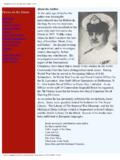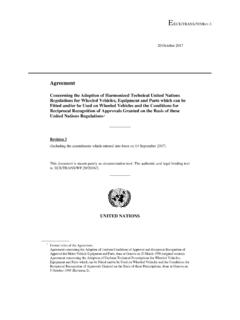Transcription of A Review of Brainstorming Research: Six Critical …
1 A Review of Brainstorming Research: Six Critical Issues for InquiryScott G. Isaksen Creativity Research UnitCreative Problem Solving Group - Buffalo Buffalo, New YorkMonograph #302 June, 1998 Author Note: The author would like to thank Stanley S. Gryskiewicz, Sidney J. Parnes, Morris and Donald J. Treffinger for helpful comments on an earlier draft of this , many thanks to Eileen Beaton Colling who demonstrated keen scholarly interestand assistance with this research while a graduate student at the Center for Studiesin Creativity, Buffalo State College. Copyright 1998. Creative Problem Solving Group - Buffalo.
2 All rights reserved. #302-Brainstorm 1/11/01 1:28 PM Page 1 AbstractBrainstorming is one of the most well-known tools for creative thinking. Many empiricalstudies have been conducted regarding the effectiveness of this approach to groupidea generation. Few previous reviews have considered more than one or two dozenstudies and they have ignored a few fundamental issues outlined by the inventor ofthe tool. This condition has led to some unfortunate misconceptions about brain-storming. This article provides a Review of 50 studies done from 1958 to 1988. Theyare examined on the basis of six major issues and interpreted by considering 40 addi-tional studies conducted since 1988.
3 The aim is to take stock of what we know andpoint out productive pathways for future #302-Brainstorm 1/11/01 1:28 PM Page 2 IntroductionThe purpose of this article is to critically Review the empirical literature on brain-storming in light of six major issues which, together with their implications, challengethe prevailing paradigm and suggest entirely different pathways for improved presenting the results of the Review , the term Brainstorming will be defined andan abbreviated summary of how Osborn actually presented this well-knowngroupapproach to idea generation is given. The Yale study (Taylor, Berry & Block, 1958)that formed the foundation for a great deal of the empirical work will be summarizedand examined in light of Osborn s suggestions and best-case application for brain-storming.
4 The Beaton (1990) study results will be presented with a summary of morecurrent Brainstorming research organized around the six major issues. Finally, sug-gestions and recommendations for future Brainstorming research will be is probably one of the most well-known tools of creative problemsolving (Fernald & Nickolenko, 1993; Leclef, 1994; Stein, 1975). Its popularity stemsfrom the long-standing and pervasive need to improve the productivity of groups. It issimple, easy to learn, and has potential to dramatically improve group idea generationand enjoyment with the activity itself. Brainstorming s widespread familiarity is alsoexplained by the fact that it was introduced in 1939 by an advertising executive whohad expertise and experience with the process of selling ideas.
5 In his widely-distributed book Applied Imagination,Osborn (1953) outlined a varietyof tools and approaches to creative problem solving (CPS). He made some bold asser-tions regarding Brainstorming s effectiveness. Osborn backed up his claims by indi-cating that, in one study, a group using Brainstorming produced 44% more worthwhileideas than individuals thinking up suggestions without the benefit of group were eager to try this new approach, and it quickly became a sensation. Thisincreased popularity created some misunderstanding and misuse of the term and thetool. For those who jumped on the bandwagon, Brainstorming had become the word Brainstorming has taken on a variety of popular meanings.
6 For some itmeans simply to get together and have a casual discussion in order to come up with a fewideas. Some believe that the term Brainstorming is the same thing as idea others, Brainstorming is a universal treatment (the only way to be creative) orsynonymous with the entire CPS process. For others, it was used as a derogatoryterm implying a waste of a recent conference, one National Science Foundation official indicated that ..we all know that Brainstorming is nothing more than executive entertainment. Current and popular organizational consultants and writers have often referred tobrainstorming as cerebral popcorn, nothing more than a crapshoot, or as a leadinginternational authority on the direct teaching of creative thinking indicated:Those who want to use deliberate creativity believe that the (weak) processes of Brainstorming areenough.
7 Others who might be motivated to develop creative thinking skills are turned off by the scat-ter-gun approach of Brainstorming . The idea that from a ferment of consideration an idea mightemerge which might be useful has value in the advertising world (where Brainstorming originated) butmuch less value where novelty is not, by itself, a sufficient value (de Bono, 1992).While the term Brainstorming may be widely diffused, people hold various and3#302-Brainstorm 1/11/01 1:28 PM Page 3conflicting meanings for the term. For many professionals who work with individuals,groups, and organizations to educate and nurture creative abilities and skills, brain-storming has a specific and more technical definition.
8 It may be helpful to examinein more detail how the original proponent described s Best-Case Description of BrainstormingOsborn (1942, 1948, 1952a & b, 1953, 1957, 1963, 1967) felt that the creative pro-ductivity of groups was often hindered due to the primarily evaluative orientation ofmost meetings. His popular metaphor for this condition was described as driving withthe brakes on. He designed the Brainstorming session as a creative conference for thesole purpose of producing a checklist of ideas which can subsequently be evaluated andfurther processed. Brainstorming was identified as only one of a variety of tools forgenerating ideas, and idea generation was outlined as only one aspect of the entirecreative problem-solving process.
9 Group Brainstorming was suggested as a supplementto individual ideation, not a four basic guidelines:A central principle involved in Brainstorming was described as deferment of judg-ment, which meant the postponement of judgment during generating phases of (1953) included deferment of judgment as only one of the four central guidelinesfor Brainstorming to respond to the over emphasis of judicial thinking that dominatedmost meetings and conferences. The four guidelines he developed were:1. Criticism is ruled out. Adverse judgment of ideas must be withheld until purpose of the Brainstorming session is the generation of many, varied andunusual Freewheeling is welcomed.
10 The wilder the idea, the better; it is easier to tamedown than to think up. Since criticism is temporarily ruled out, it s acceptableand desired that really wild and unusual ideas are Quantity is wanted. The greater the number of ideas, the greater the likelihoodof useful Combination and improvement are sought. In addition to contributing ideas oftheir own, participants should suggest how the ideas of others can be turned into better ideas; or how two or more ideas can be joined into still another idea.(p 300-301.)Although deferment of judgment was the central principle outlined by Osborn, hemade it clear that judgment had an important role to play in the total CPS the purpose of Brainstorming was for group generation of options, sorting andevaluation were postponed and became the main agenda for another separate four guidelines were central for successful Brainstorming , but Osborn wasclear that they were not sufficient.


![THINGS FALL APART [1958] - …](/cache/preview/c/b/e/3/f/6/b/d/thumb-cbe3f6bd22cf6fa0d0cb888d7d467f40.jpg)





